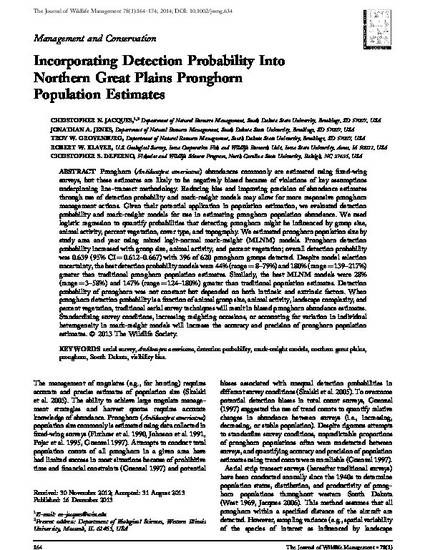
Pronghorn (Antilocapra americana) abundances commonly are estimated using fixed-wing surveys, but these estimates are likely to be negatively biased because of violations of key assumptions underpinning line-transect methodology. Reducing bias and improving precision of abundance estimates through use of detection probability and mark-resight models may allow for more responsive pronghorn management actions. Given their potential application in population estimation, we evaluated detection probability and mark-resight models for use in estimating pronghorn population abundance. We used logistic regression to quantify probabilities that detecting pronghorn might be influenced by group size, animal activity, percent vegetation, cover type, and topography. We estimated pronghorn population size by study area and year using mixed logit-normal mark-resight (MLNM) models. Pronghorn detection probability increased with group size, animal activity, and percent vegetation; overall detection probability was 0.639 (95% CI = 0.612–0.667) with 396 of 620 pronghorn groups detected. Despite model selection uncertainty, the best detection probability models were 44% (range = 8–79%) and 180% (range = 139–217%) greater than traditional pronghorn population estimates. Similarly, the best MLNM models were 28% (range = 3–58%) and 147% (range = 124–180%) greater than traditional population estimates. Detection probability of pronghorn was not constant but depended on both intrinsic and extrinsic factors. When pronghorn detection probability is a function of animal group size, animal activity, landscape complexity, and percent vegetation, traditional aerial survey techniques will result in biased pronghorn abundance estimates. Standardizing survey conditions, increasing resighting occasions, or accounting for variation in individual heterogeneity in mark-resight models will increase the accuracy and precision of pronghorn population estimates.
Available at: http://works.bepress.com/robert-klaver/56/

This article is published as Jacques, C. N., Jenks, J. A., Grovenburg, T. W., Klaver, R. W. and Deperno, C. S. (2014), Incorporating detection probability into northern Great Plains pronghorn population estimates. Journal of Wildlife Management., 78: 164–174. doi:10.1002/jwmg.634.